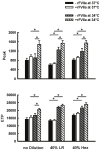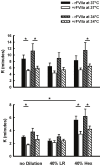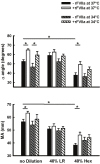Effects of In vitro hemodilution, hypothermia and rFVIIa addition on coagulation in human blood
- PMID: 22928166
- PMCID: PMC3415967
Effects of In vitro hemodilution, hypothermia and rFVIIa addition on coagulation in human blood
Abstract
Introduction: Coagulopathy can occur after hemorrhage, trauma and resuscitation, and has been associated with dilution of coagulation factors and hypothermia. Recombinant activated Factor VII (rFVIIa) has been used, often as a last resort, to improve hemostasis in trauma/hemorrhage patients with coagulopathy. The aim of this study was to further characterize the effects of rFVIIa on various coagulation parameters and the influence of temperature and hemodilution.
Methods: WHOLE BLOOD FROM HEALTHY HUMAN VOLUNTEERS WAS INCUBATED IN A COMBINATION OF THREE CONDITIONS: undiluted or diluted 40% with either lactated Ringer's solution or Hextend, at 37°C or 34°C, and with and without rFVIIa (1.26 μg/ml, final concentration). Blood or plasma, as appropriate, was measured for coagulation by thrombin generation, thromboelastography (TEG), prothrombin Time (PT) and activated partial thromboplastin (aPTT).
Results: Incubation of plasma at 34°C significantly elevated thrombin generation, and prolonged PT and aPTT. Dilution of blood or plasma with 40% Hextend, but not lactated Ringer's, had a significant effect on TEG parameters, and prolonged PT and aPTT. In control conditions (37°C, 0 dilution), the addition of rFVIIa to human plasma or whole blood led to a significant change in all TEG parameters, and Lagtime for thrombin generation, but not to PT or aPTT.
Conclusion: Theses data show that thrombin generation is affected by hypothermia, but not 40% dilution. TEG is affected by 40% dilution with Hextend, but not by hypothermia. PT and aPTT are significantly affected by both hypothermia and dilution. Recombinant FVIIa caused a greater change in thrombin generation at 34°C as compared to 37°C, and a greater change in PT at 40% dilution, suggesting that the effect of rFVIIa on coagulation is both temperature and dilution dependant.
Keywords: PT; TEG; aPTT; thrombin generation.
Figures






Similar articles
-
Effect of hemodilution on coagulation and recombinant factor VIIa efficacy in human blood in vitro.J Trauma. 2011 Nov;71(5):1152-63. doi: 10.1097/TA.0b013e318215178c. J Trauma. 2011. PMID: 21610535
-
Controlled Multifactorial Coagulopathy: Effects of Dilution, Hypothermia, and Acidosis on Thrombin Generation In Vitro.Anesth Analg. 2020 Apr;130(4):1063-1076. doi: 10.1213/ANE.0000000000004479. Anesth Analg. 2020. PMID: 31609256
-
Thrombelastography is better than PT, aPTT, and activated clotting time in detecting clinically relevant clotting abnormalities after hypothermia, hemorrhagic shock and resuscitation in pigs.J Trauma. 2008 Sep;65(3):535-43. doi: 10.1097/TA.0b013e31818379a6. J Trauma. 2008. PMID: 18784565
-
Coagulation Testing in the Core Laboratory.Lab Med. 2017 Nov 8;48(4):295-313. doi: 10.1093/labmed/lmx050. Lab Med. 2017. PMID: 29126301 Review.
-
Potential role of recombinant factor VIIa as a hemostatic agent.Clin Adv Hematol Oncol. 2003 Feb;1(2):112-9. Clin Adv Hematol Oncol. 2003. PMID: 16224390 Review.
Cited by
-
Asphyxia by Drowning Induces Massive Bleeding Due To Hyperfibrinolytic Disseminated Intravascular Coagulation.Crit Care Med. 2015 Nov;43(11):2394-402. doi: 10.1097/CCM.0000000000001273. Crit Care Med. 2015. PMID: 26327200 Free PMC article.
-
In vitro assessment of effects of hyperglycemia on the optical properties of blood during coagulation using optical coherence tomography.Lasers Med Sci. 2015 Jan;30(1):413-20. doi: 10.1007/s10103-014-1679-0. Epub 2014 Nov 8. Lasers Med Sci. 2015. PMID: 25380667
-
The challenge in management of hemorrhagic shock in trauma.Med J Armed Forces India. 2014 Apr;70(2):163-9. doi: 10.1016/j.mjafi.2014.03.001. Epub 2014 Apr 13. Med J Armed Forces India. 2014. PMID: 24843206 Free PMC article. Review.
-
Patient blood management in obstetrics: prevention and treatment of postpartum haemorrhage. A NATA consensus statement.Blood Transfus. 2019 Mar;17(2):112-136. doi: 10.2450/2019.0245-18. Epub 2019 Feb 6. Blood Transfus. 2019. PMID: 30865585 Free PMC article.
-
Correction of hypothermic and dilutional coagulopathy with concentrates of fibrinogen and factor XIII: an in vitro study with ROTEM.Scand J Trauma Resusc Emerg Med. 2014 Dec 16;22:73. doi: 10.1186/s13049-014-0073-z. Scand J Trauma Resusc Emerg Med. 2014. PMID: 25510409 Free PMC article.
References
-
- Borgman MA, Spinella PC, Perkins JG, Grathwohl KW, Repine T, Beekley AC, Sebesta J, Jenkins D, Wade CE, Holcomb JB. The ratio of blood products transfused affects mortality in patients receiving massive transfusions at a combat support hospital. J Trauma. 2007;63:805–813. - PubMed
-
- Mikhail J. The trauma triad of death: hypothermia, acidosis, and coagulopathy. AACN Clin Issues. 1999;10:85–94. - PubMed
-
- Schreiber MA. Coagulopathy in the trauma patient. Curr Opin Crit Care. 2005;11:590–597. - PubMed
-
- Tieu BH, Holcomb JB, Schreiber MA. Coagulopathy: its pathophysiology and treatment in the injured patient. World J Surg. 2007;31:1055–1064. - PubMed
-
- Darlington DN, Jones RO, Magnuson TA, Gann DS. Role of intestinal fluid in restitution of blood volume and plasma protein after hemorrhage in awake rats. Am J Physiol. 1995;268:R715–722. - PubMed
LinkOut - more resources
Full Text Sources
Research Materials
